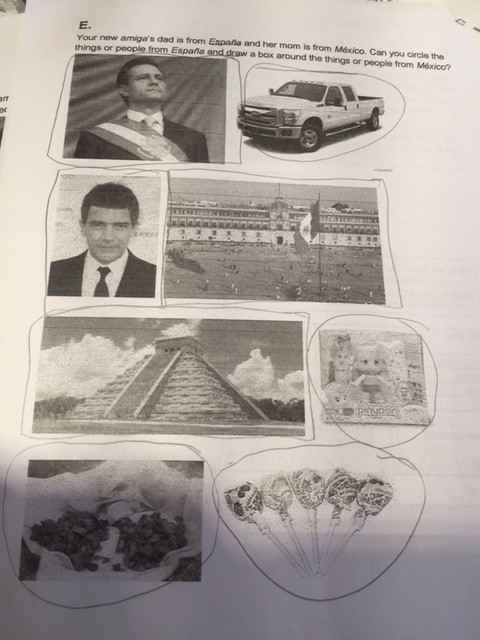December found us doing our first formal assessment of the semester. That is my reality this year, and I love it. We go at our own pace and make our own rules and I don’t see my students enough to warrant spending our precious class time on assessment instead of engaging ourselves with the language. On the other hand, stopping at the end of the semester to do an assessment both gives kids and parents some tangible evidence of what we’re achieving and a ton of helpful information for me on what we need to work on.
But in contemplating how to do this, my mind screeched to a halt. I had never done a formal assessment for young early language learners. I thought and tweaked for a long time to put together an assessment I liked, and here I want to share it with you and what I learned from it.
The Assessment
To view and download the assessment, click here.
Scenario
All the tasks are framed around a situation that is quite plausible in our city: the child meets a Spanish-speaking child at the zoo’s playground.
Interpersonal: Finding out about someone
I played “Marta” and asked children to find out my name, age, origin, likes, etc. I waited to see if they could initiate this inquiry, and if it was clear they couldn’t, I initiated finding out these things about them, and they used “¿Y tú?” to toss the questions back to me.
Interpretive listening
My friend Pilar recorded herself describing the girl’s mother (see document for audio link). Children were to listen to the audio 3 times and circle the woman they identified as the mom (I couldn’t afford to copy the assessment in color but I projected the photo in color). Then they needed to justify their answer to me (in English or Spanish).

Presentational speaking
We’ve been working on my adaptation of Bears in Chairs as our novice-low story this year. I asked students to tell me whatever they could about one of the final pictures in the book.
(Side anecdote, my students “performed” this story with one of them narrating at our end-of-semester celebration. The narrator, when the third osito came out, said “cuatro ositos,” and my 3-year-old who was interestedly wandering around their performance gave him a “doh” look at said, “TRES ositos.”)
Interpretive reading
A while back I found an amazing authentic resource in which a bunch of children comment on a blog and introduce themselves, often with interesting novice-level details. I copied three comments into the assessment and asked children to chart some of this information that they understood. Then I asked them to write a similar comment based on their own likes and interests.

I am proud of her!
Interpretive cultural awareness
I asked students to perform our novice level cultural awareness goal. I gave them a series of images (also projected in color for the flag help) and asked them to identify which were from Spain and which from Mexico. I included two images of U.S. products. (I was amused that one kid said Chichén Itzá was in Spain; I would have thought that to be the one they would all get right – it was also a focus in their Maya lesson in history class this semester.)

(tacos don’t hail from Spain either…)
The lessons learned
Age factor
My 9-12 year-olds knocked this out of the park. Not so much in performing way above their expected level, but they understood what was going on, worked at it diligently, clearly felt comfortable with it (with one notable exception) and gave me answers on most sections.
My 6-8 year-olds, including my own bilingual (reluctant speaker) daughter, were overwhelmed. The format wasn’t friendly enough, the directions weren’t clear enough, the content was too long. I’m not sure I’ll even ask them to do the assessment in the spring, but if I do, I’ll pare it down. I need to cut the scenario altogether and just ask them questions to see if they can answer. Asking them to circle a described picture: fine. Asking them to write a justification: no way. Asking them to identify information in three blog comments: too much. One well-selected text would have been plenty. Especially with some cute kid-friendly formatting.
Design tweaks
I knew going into this that my students had not had enough practice on finding out where someone lives or is from. I asked this question myself. I think one of them was able to initiate it.
¿Qué te gusta? was a fine question. Adding hacer – that we had not had enough interaction with.
I originally gave them all the names in the chart on interpretive reading. Why? I don’t know. Of all information that would have been their most successful endeavor to find out.
It was helpful to find out a little more about why a child circled the wrong mom in the photo; my fastest-processing high-aptitude 9-year-old told me he heard baja at least twice but also heard negro twice so he circled the woman who was wearing two black articles of clothing. Okay, I get that.
Emphasizing the journey
Some of my kids were only able to say a few words about the Bears picture. Ositos. Cuatro las sillas. That was fine. “Are you done?” I asked. Nod. “Okay, great! Thanks!” In our learning community we are all about the journey – what can you do now, and where are we headed next. It’s an adventure much more inspiring than “how are you doing compared to X” or “can you get a high enough grade to Y”. And the younger kids, leaving sections blank, that was fine. We just talked about it. Sometimes I was able to help them discover they could do things they didn’t know they could do. I had one 9-year-old absolutely shut down on the interpersonal task with me. She claimed she didn’t know how to find out any of these things. She wasn’t upset or crying but rather was almost antagonistic. “I can’t do any of this.” I said, “Okay, I’ll ask the questions first and see what you can do then.” She was able to record my answers in the appropriate place (listening skill!) and use y tú to give me back the question. I said, “See? You could do a lot with this!”

but great job with bonita!
Have you tried a summative assessment with young learners? How are they showing you what they can do?
As for scoring – I do not give grades and none of my parents keep them either. I’m providing these assessments with my new elementary rubric for them to put in the children’s school progress portfolios.
1 Comments
Comments are closed.





[…] one integrated performance assessment. See an example of my early learners’ work on that here. You can check out my secondary assessment for the end of the year […]